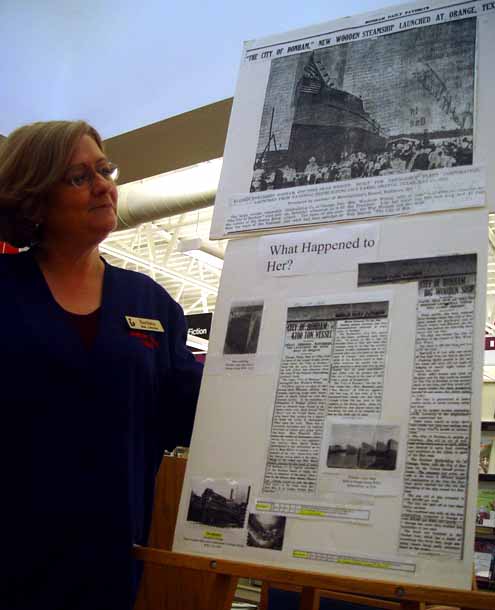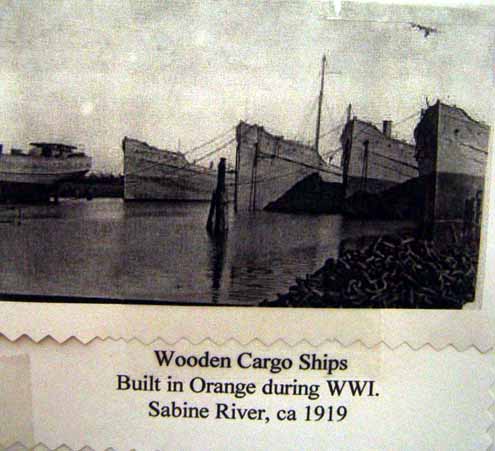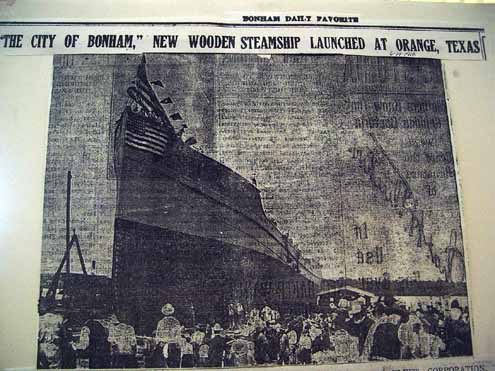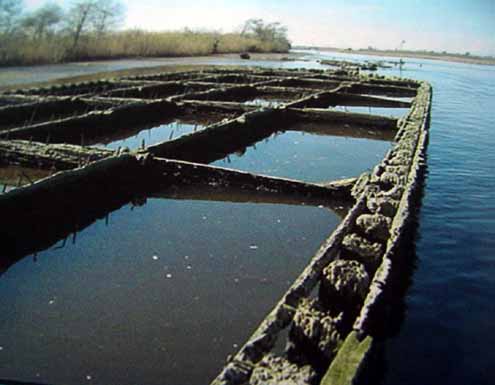Many years ago a talented songwriter named Steve Goodman penned the words that made an Illinois Central train called The City of New Orleans famous. Too bad no one did the same for a ship called the City of Bonham. It just might offer a clue to her fate.
The City of Bonham was a massive wooden steamship that slid into the water of the Sabine River at Orange, Texas on the afternoon of May 11, 1918. With a capacity of 4,700 tons, the City of Bonham, along with her sister ships the War Marvel and the War Mystery, was considered the largest wooden steamship afloat at the time. And speaking of mysteries, no one seems to know what actually became of the City of Bonham. The ship, that is.
 |
|
Barbara McCutcheon looks over newspaper clippings detailing the history of shipbuilding in East Texas. |
No one loves a good project more than Barbara McCutcheon and, as executive director of the Bonham Public Library, Mrs. McCutcheon always has something of particular interest featured at the library. Barbara had a full head of steam on a project to collect historical photographs of Fannin County when she uncovered data about this super-sized steamship designed to carry freight during World War I. The Bonham Public Library has a display featuring everything the staff has uncovered to this point, but several questions linger.
Why was the largest wooden steamship of her era named after a quiet, little town in North Texas?
McCutcheon has discovered that the ship was given her name by Mrs. Woodrow Wilson, but what made the president’s wife decide to bestow this honor on Bonham?
And what became of this massive marvel made of East Texas pine?
Libraries are unique centers of learning, and the facts already uncovered by the inquisitive staff at the Bonham Public Library provide an enlightening glimpse into the history of East Texas shipbuilding.
 |
|
|
The National Shipbuilding Company in Orange, Texas contracted with the U.S. government to construct just over a dozen of these wooden giants to carry freight during the war effort. Although eventually some of these ships burned, some sank, some were lost at sea and one reportedly fell victim to a U-boat, their combined effort was considered a success. Originally designed to deliver cargo to Europe, most accounts indicate these giant steamships did exactly that.
An article in the Bonham Daily Favorite said the City of Bonham was big enough that “every man, woman and child in Bonham and his dog” would fit on the ship’s decks and this floating monster could haul all their household goods, as well. The article went on to say this massive vessel was 47-feet wide, 50-feet high and could hold 155 carloads of freight, or nearly eight trains of twenty cars each (figured at 60,000 pounds for each car).
The City of Bonham was more than a football field long, 320 feet to be exact. Now, that took a lot of yellow pine!
 |
|
photo of old newspaper clipping of the City of Bonham |
To launch a ship of this scale was a remarkable feet unto itself. The May 14, 1918 edition of the Bonham Daily Favorite described the scene like this:
"For over 30 minutes an army of men swung their hammers driving the wedges, removing props while thousands of people looked on with the keenest anxiety. In the meantime a delegation of Bonham citizens occupied an elevated stage draped in patriotic colors.”
Some of the Bonhamites on hand were Miss Maud Evans, the sponsor of the board of trade in Bonham, and C.R. Inglish, the secretary of the Bonham board of trade. Former Bonhamites, Rev. and Mrs. S.A. Cowen, were invited to join the delegation from Fannin County on the stage for this auspicious occasion.
Movie cameras supposedly recorded the event as bands played and “Old Glory” flew overhead.
By all accounts it was a remarkable day for the City of Bonham…the ship and the municipality.
To learn more about this fascinating period of Texas history, stop by and examine the display at the Bonham Public Library. You better hurry, though. Barbara and her staff probably already have another project in mind.
 |
|
Exhibit photo of the remains of a large wooden ship in the Sabine River. |
Lyrics to "The City of Bonham" (with apologies to Steve Goodman)
Headin' to the gulf on the City of Bonham
see how her yellow hull shines
if we even make it to deep water
then the U-boats can follow
buddy, these are dangerous times
they came down the river
with cargo to deliver
hewed out of East Texas pine
now search the Sabine
when the flow's running lean
ain't no tellin' what you gonna find